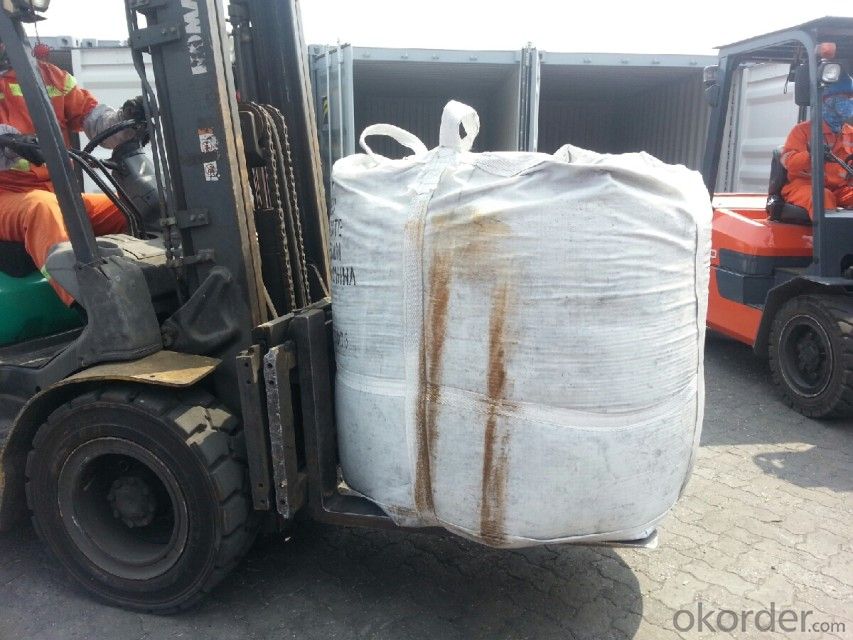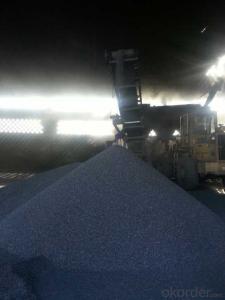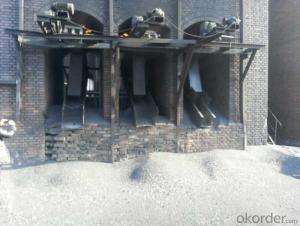Injection Carbon FC85 for Australia Market
- Loading Port:
- Tianjin
- Payment Terms:
- TT OR LC
- Min Order Qty:
- 20 m.t.
- Supply Capability:
- 5000 m.t./month
OKorder Service Pledge
OKorder Financial Service
You Might Also Like
Packaging & Delivery
Injection Carbon FC85 for Australia Market
25kgs/50kgs/1ton per bag or as buyer's request
Specifications
Injection Carbon FC85 for Australia Market
Calcined Anthracite
Fixed carbon: 90%-95%
S: 0.5% max
Size: 0-3. 3-5.3-15 or as request
Advantage and competitive of caclined anthracite:
Injection Carbon FC85 for Australia Market
1. strong supply capability
2. fast transportation
3. lower and reasonable price for your reference
4.low sulphur, low ash
5.fixed carbon:95% -90%
6..sulphur:lower than 0.3%
General Specification of Calcined Anthracite:
Injection Carbon FC85 for Australia Market
| FC | 90 | 88 | 85 | 83 | 82 |
| ASH | 8.5 | 10 | 12 | 14 | 15 |
| V.M. | 1.5 | 2 | 3 | 3 | 3 |
| S | 0.35 | 0.5 | 0.5 | 0.5 | 0.5 |
| MOISTURE | 0.5 | 1 | 1 | 1 | 1 |
Pictures


Injection Carbon FC85 for Australia Market
Advantage:
1.High quality and competitive price.
2.Timely delivery.
3.If any item you like. Please contact us.
Your sincere inquiries are typically answered within 24 hours.
- Q:Why are biological molecules carbon based molecular aggregates?
- Because living things are living organisms, most of them consist of organic compounds, which are carbon compounds, and carbon chains are the main body
- Q:How to match?Want to breed a batch of roses seedlings, but the seedbed of mud, carbon soil do not know how to get, there is help in this regard...
- Clay soil can not be prepared, it was completed by geological changes over the past ten thousand years. Flower cultivation of soil can be self-made, mud carbon 3 points, coconut bran 2 points, perlite a point. The three proportion is 3; 2; 1.
- Q:What are the effects of carbon emissions on the stability of estuaries?
- Carbon emissions have significant effects on the stability of estuaries. Increased carbon dioxide in the atmosphere leads to ocean acidification, which negatively impacts the delicate balance of estuarine ecosystems. Acidic waters can harm the growth and survival of estuarine plants and animals, disrupt the food web, and reduce biodiversity. Additionally, carbon emissions contribute to global warming, leading to rising sea levels and increased storm intensity, which can cause erosion and flooding in estuaries. Overall, carbon emissions pose a threat to the stability and health of estuaries, with potentially far-reaching ecological consequences.
- Q:What are fossil fuels and how are they formed?
- Fossil fuels, derived from ancient plants and animals, are natural resources utilized by humans for centuries as non-renewable sources of energy. Coal, oil, and natural gas comprise the three primary types of these fuels. The genesis of fossil fuels commences with organic matter sourced from plants and animals. Over millions of years, this organic material becomes deeply buried within the Earth's crust. Through the accumulation of sediment layers, the organic matter experiences increased pressure and heat, resulting in the process of fossilization. Regarding coal, the organic matter primarily consists of compacted and heated plant material. As the pressure and temperature rise, the plant material undergoes a gradual chemical transformation, eventually becoming coal. The formation of oil and natural gas follows a slightly different path. It originates from the remains of minuscule marine microorganisms, such as plankton, which settle at the ocean floor. Over time, these organic materials become buried beneath sediment layers, where they endure immense heat and pressure. Under these conditions, the organic matter undergoes a conversion into a mixture of hydrocarbons, serving as the primary constituent of oil and natural gas. Subsequently, the oil and gas migrate through porous rocks until they become trapped by impermeable layers, giving rise to oil or gas reservoirs. Overall, the formation of fossil fuels constitutes a gradual geologic process taking millions of years. It necessitates specific conditions of heat, pressure, and burial to convert organic matter into coal, oil, or natural gas. Due to their limited availability and the environmental consequences associated with their combustion, there is an increasing emphasis on transitioning towards renewable energy sources as a more sustainable alternative.
- Q:What are the impacts of carbon emissions on the stability of tundra ecosystems?
- The impacts of carbon emissions on the stability of tundra ecosystems are significant and wide-ranging. Carbon emissions, primarily in the form of greenhouse gases such as carbon dioxide and methane, contribute to global warming and climate change. As a result, the tundra ecosystems, which are particularly vulnerable to temperature changes, experience several negative effects. Firstly, increased carbon emissions lead to rising temperatures, causing the permafrost in the tundra to thaw. Permafrost is a layer of permanently frozen soil that acts as a foundation for the tundra ecosystem. When it thaws, the stability of the entire ecosystem is compromised. The ground becomes unstable, leading to collapsing landscapes, landslides, and altered drainage patterns. This can disrupt plant and animal habitats, as well as impact the distribution of water resources. Secondly, as permafrost thaws, organic matter that has been frozen for thousands of years starts to decompose. This decomposition process releases large amounts of carbon dioxide and methane into the atmosphere, further exacerbating the greenhouse effect. This positive feedback loop accelerates climate change and contributes to the overall increase in carbon emissions. Furthermore, the thawing of permafrost also affects the vegetation in tundra ecosystems. Many plant species in the tundra rely on the permafrost layer for stability and nutrient availability. With its degradation, plants face difficulties in establishing and maintaining their root systems. This, in turn, reduces plant productivity and alters the composition of plant communities. Changes in vegetation can impact wildlife, such as reindeer, caribou, and migratory birds, which depend on specific plant species for food and shelter. Additionally, the increased thawing of permafrost releases previously trapped pollutants and contaminants, which can further harm the stability of tundra ecosystems. These pollutants, such as heavy metals and toxic chemicals, can enter waterways and affect aquatic life, disrupting the delicate balance of the ecosystem. Overall, carbon emissions contribute to the destabilization of tundra ecosystems through the thawing of permafrost, alteration of vegetation, release of greenhouse gases, and contamination of water resources. These impacts not only affect the tundra's unique biodiversity but also have implications for global climate change. It is crucial to reduce carbon emissions and mitigate the effects of climate change to preserve the stability and integrity of these fragile ecosystems.
- Q:Last night to go to the supermarket to buy 5 batteries, see Toshiba carbon batteries, I finally bought the super alkaline batteries, alkaline batteries and carbon is the difference in where? What kind of battery is best for digital cameras? Thank you
- Because the ingredients still contain cadmium, and therefore must be recovered, so as to avoid damage to the environment of the earth.Alkaline batteries are suitable for large power consumption and long time use. The internal resistance of the battery is low, resulting in the current general Zn Mn batteries, is conductive copper, steel shell shell is safe and reliable. No need to recycle. Based on his environmental protection, and the current characteristics of large, so now alkaline battery more.
- Q:How does carbon contribute to the strength of alloys?
- Carbon contributes to the strength of alloys by forming interstitial solid solutions with metals, which increases the hardness and strength of the material. The carbon atoms occupy the spaces between the metal atoms, creating lattice distortions and enhancing the overall strength of the alloy. Additionally, carbon can also form compounds with metals, such as carbides, which further improve the hardness and wear resistance of alloys.
- Q:How does carbon affect the formation of acid rain?
- Carbon does not directly affect the formation of acid rain. Acid rain is primarily caused by emissions of sulfur dioxide and nitrogen oxides, which react with water, oxygen, and other chemicals in the atmosphere to form sulfuric acid and nitric acid. However, carbon dioxide, a greenhouse gas emitted from the burning of fossil fuels, contributes to climate change. Climate change can alter weather patterns and increase the frequency and intensity of precipitation, which can indirectly affect the acidity of rain.
- Q:What are the impacts of carbon emissions on the stability of mangroves?
- Mangroves, crucial coastal ecosystems, are negatively affected by carbon emissions, which have detrimental effects on their stability. The increased levels of carbon dioxide (CO2) in the atmosphere contribute to global warming, resulting in rising sea levels and more frequent and intense storms. These changes directly impact mangroves in several ways. Firstly, global warming causes rising sea levels, leading to more frequent inundation of mangroves. As the sea level rises, saltwater intrusion occurs more often, disrupting the delicate balance of saltwater and freshwater in mangrove ecosystems. This can displace and cause a decline in mangroves, as they struggle to adapt to the changing conditions. Secondly, the increased frequency and intensity of storms due to climate change can physically damage mangroves. Mangroves act as a natural barrier, absorbing wave energy and protecting coastlines from storm surges. However, stronger storms test the resilience of mangroves, potentially uprooting or destroying them, leaving the coastlines vulnerable to erosion and further damage. Additionally, carbon emissions are linked to ocean acidification, which occurs when excess CO2 is absorbed by the oceans. Acidic waters negatively impact the growth and development of mangroves, as they are sensitive to changes in pH levels. This can lead to reduced productivity, stunted growth, and even death of mangroves, further destabilizing these ecosystems. The stability of mangroves is crucial for both the environment and human populations. Mangroves provide essential habitats for various species, acting as a nursery for fish and supporting biodiversity. They also serve as carbon sinks, absorbing significant amounts of CO2 from the atmosphere. Furthermore, mangroves play a vital role in coastal protection, mitigating erosion, storm surges, and flooding impacts. To mitigate the effects of carbon emissions on mangrove stability, it is crucial to reduce greenhouse gas emissions and limit global warming. This can be achieved by adopting clean energy sources, implementing conservation efforts, and initiating reforestation projects. Equally important is the protection and restoration of mangrove habitats, as this helps maintain their stability and resilience to climate change impacts.
- Q:I don't know the battery. Although I know the former is chemical energy, I want to know if the 1 grain size 5 can compare the charge capacity with the 1 grain 5 1ANot much of a fortune, but thank you very much for the enthusiastic friend who gave me the answer. Thank you!
- The typical capacity of a AA carbon cell is 500maH, the voltage is 1.4V (average discharge platform) and the power is 0.7WHA typical capacity of AA alkaline battery is 2800maH, the voltage is 1.4V (average discharge platform) and the power is 3.9WHA AA disposable lithium iron battery, the typical capacity is 3000maH, voltage is 1.5V (discharge platform average), power is: 4.5WHA AA nickel hydrogen rechargeable battery, the maximum capacity is 2700maH, voltage is 1.2V (average discharge platform), power is: 3.2WHA AA lithium rechargeable battery, the maximum capacity is 800maH, the voltage is 3.7V (average discharge platform), power is: 2.9WHA AA lithium iron phosphate battery has a maximum capacity of 700maH, a voltage of 3.2V, and a power of 2.2WhBased on the above data, it is concluded that AA single iron lithium battery and disposable alkaline battery are the most durable, and their capacity (no matter size, current, discharge) is more than 6 times of that of carbon battery
1. Manufacturer Overview |
|
|---|---|
| Location | |
| Year Established | |
| Annual Output Value | |
| Main Markets | |
| Company Certifications | |
2. Manufacturer Certificates |
|
|---|---|
| a) Certification Name | |
| Range | |
| Reference | |
| Validity Period | |
3. Manufacturer Capability |
|
|---|---|
| a)Trade Capacity | |
| Nearest Port | |
| Export Percentage | |
| No.of Employees in Trade Department | |
| Language Spoken: | |
| b)Factory Information | |
| Factory Size: | |
| No. of Production Lines | |
| Contract Manufacturing | |
| Product Price Range | |
Send your message to us
Injection Carbon FC85 for Australia Market
- Loading Port:
- Tianjin
- Payment Terms:
- TT OR LC
- Min Order Qty:
- 20 m.t.
- Supply Capability:
- 5000 m.t./month
OKorder Service Pledge
OKorder Financial Service
Similar products
New products
Hot products
Related keywords






























